In 2018, when a number of works were moved from the Magritte Museum to the San Francisco Museum of Modern Art for an exhibition focused on the iconic Brussels surrealist, Nicolas Party was invited to fill in the empty spots. In a new book, the Swiss artist who currently divides his time between New York and Brussels, reflects on that “intimate little moment” with the master.
© Magritte Parti: Magritte Museum, Brussels, 2018 - Courtesy: the artist and Xavier Hufkens, Brussels
| René Magritte’s “Black Magic” (1945) and Nicolas Party’s “Red Portrait” (2018)
“Well, the way to approach it is never to compare yourself to those artists, whether it's Magritte, Picasso, or even Zidane,” Nicolas Party advises us with a smile. “You're only going to get depressed if you do. You can't enter such a project thinking: 'I hope my painting is going to be as good as Magritte's.' Of course it won't be – he is one the most important artists of the twentieth century. It is not a competition.”
“To me, this whole experience was like a little experiment. You come into the museum, you fill in the empty spots discretely, ensuring that you don't disturb the 99% of visitors who aren't even aware that you're part of the exhibition, and after a few months, you're out again. You're putting on a show, it's visual art, not something where you have a very real impact on the actual lives of people. If you realize that, you don't feel nervous or stressed at all. If you want to play, just enjoy playing.”
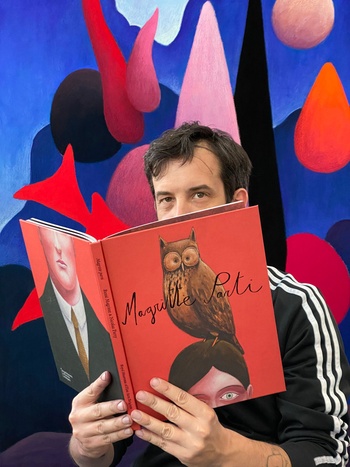
Nicolas Party
Playful is precisely the word to describe the approach that the Swiss-born artist, who is currently living between Brussels and New York, took in “this unique and unreal project”. “It started with Michel (Draguet, director of the Royal Museums of Fine Arts and driving force behind the Magritte Museum, ed.) saying that he had all of these different Magritte paintings leaving for the San Francisco Museum of Modern Art, and suggested that I fill in the blanks they left. I took it very literally. (Laughs) I did versions of the missing paintings, like the Thomson and Thompson one, referencing Magritte's Fifth Season. Sometimes I went so far as to make blatant copies, adding an extra touch of surrealism to my work, putting a ball on top of a head, adding an owl, or creating a marble-like mural. There are a lot of things that I hadn't done before.”
THE SEVEN YEAR ITCH
And yet it is undeniably Nicolas Party you're looking at, the artist who uses pastels, long-forgotten in the rest of the art world, to create delightfully efflorescent, sweet, sensuous, and unusual, utterly artificial and yet strangely spirited portraits, landscapes, and still lives. Whose head concocts luscious and mysterious 3D objects, and transforms the white walls of museums and galleries into powerful and brightly coloured backdrops, turning every exhibition into a real experience. And who after utterly unique solo shows at Xavier Hufkens, the Hirshhorn Museum in Washington, the Hammer Museum in Los Angeles, the Dallas Museum of Art, The Modern Institute in Glasgow, and the Flag Art Foundation in New York has been catapulted far beyond the epithet of “rising star of the contemporary art world”. Last year, he found a permanent home at the prestigious Hauser & Wirth gallery. That same year, Nicolas Party became the top-performing artist under 40 at auction, and last summer was the first time that he sold a canvas, Still Life from 2015, for more than one million dollars during Christie's online sale “One: A Global Sale of the 20th Century”.
Never compare yourself to Magritte, Picasso, or even Zidane, you’re only going to get depressed if you do
All this attention and recognition does not appear to affect him. The man who speaks to us via a trans-Atlantic telephone connection from his studio in New York, is still just the kid who painted graffiti when he was twelve, who got caught doing so at 21, and then decided to go to art school in Lausanne and Glasgow, afterwards spending quite a few years doing 3D animation. “I was already doing characters and landscapes in my graffiti days. Those pieces I did back then are not so different from what I'm doing now. Even the energy is pretty much the same. The thrill of doing things on the spot, improvised. The sketch of the mural at the Magritte Museum, I did it on the stairs the day I painted it. (Laughs) It makes it very alive. Like a performance, very physical, very emotional. I also still use these very bright, graphic colours and strong contrasts, that made sure that my works popped and that they were seen… I've been trying to turn that down, to be less 'loud', but it's inescapable.” (Laughs)
His encounter with Magritte appears equally unavoidable. “That was in 1987, at the Fondation de l'Hermitage in Lausanne,” Nicolas Party laughs. “I remember it pretty well, because my mom and dad's best friends were the people taking care of the building, and they lived just next door. The museum is not that big, but it's a beautiful place, located on top of a hill, in a huge park. As a child, I was always going there because it was such a great place to play. Obviously, I almost never missed a show, and in 1987 they did a Magritte exhibition there. For a long time, my parents had the poster hanging in their apartment. I was only seven years old and I don't remember everything I saw back then, but I do know that his work, his language, and this strange world that I discovered immediately spoke to me.”
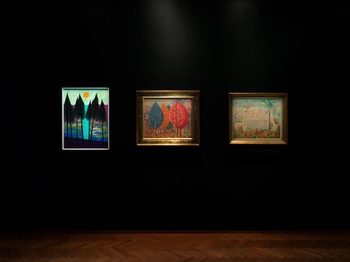
Nicolas Party’s “Sunset” (2018) next to René Magritte’s “The Blaze” (1943): “Art is raising questions that can’t be answered, creating objects that can’t be resolved. Magritte is a master at that.”
Twenty-five years later, after a game of push – because Magritte's iconic oeuvre echoed too loudly – and pull – by seeing the 2008 exhibition at the Schirn Kunsthalle in Frankfurt, “focusing on these crazy, energetic works from Magritte's 'période vache'” – Nicolas Party moved to Brussels. “The same place he used to live! I started to see Magritte paintings on a regular basis, visiting the Magritte Museum fairly often and seeing his work in other places.” This was very fertile soil for what would become his “intimate little moment” with the master in 2018.
NO SOUND BUT THE ECHO
That moment in 2018 electrified the Magritte Museum, as is evident from the recently published book – aptly and playfully titled Magritte Parti (“Magritte gone”) – that looks back at the unique rendez-vous between dream and reality. And yet there is a major difference between René Magritte and Nicolas Party: while the first turns reality upside down by injecting it with the stuff that dreams are made of, the second needs no such foundation. “Exactly. In Magritte's work there are actual people, you see his wife, his house, all sorts of objects taken from reality, and he puts them in another world. While my work has no actual connection to reality. Sure, you see these long lines with a circle on top, and your brain tells you that that's a tree. But it's not. It's more like the symbol of a tree. The same goes for my portraits. These people only exist within the painting. Or take all the fruits that I paint. Their shape, their size, their colours...they don't look like anything you know from reality, but you cannot but think they're fruits and vegetables. I like the idea that there is no bridge from what is in the painting to something outside of the frame, and that it is just the language or the signs that engender a connection, not the actual objects.”
I was already doing characters and landscapes in my graffiti days. Even the energy is pretty much the same. The sketch of the mural at the Magritte Museum, I did it on the stairs the day I painted it
Nicolas Party's work is an overwhelming paradox. A bizarre twilight zone, between here and nowhere, within reach and out of time. Like the echo of a sound that never existed. “That's a beautiful way to put it! And it totally makes sense. I do like the idea of making images that are extremely understandable and readable – that's what I always loved about Hergé, the line that makes it very clear what is happening – but at the same time there is this confusion about what you're actually looking at.”
The more you look, the more seductive and problematic that tension becomes. Until the painting goes beyond the frame and settles under your skin. “That's precisely what art does, I guess. Humans have always been trying to resolve problems and questions – from the scientific to the emotional to the technical… We want to understand everything, even though we know that we're bound to fail. Art is basically embracing that feeling and energy of needing to raise questions but only capturing that, and trying to create objects that can't be resolved. Magritte is a master at that: he creates this very clear enigma, but there are no answers. That to me is a successful artwork.”
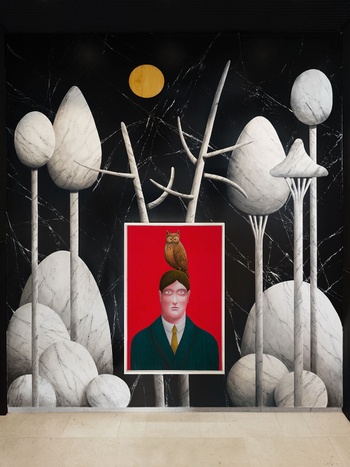
Magritte Parti: a view of Nicolas Party’s “Mural Landscape” and “Portrait with an Owl”, created in 2018 as part of his show at the Magritte Museum
“If you want to be visually entertained, don't look at a painting. (Laughs) Of course art offers visual attraction, but that's just a strategy to get people into the painting. The one thing I look for in art is to be unsettled by those unanswerable questions. It's very energizing to be in that space, you know. When you create art, that's the spot, the moment you try be in. That kind of energy lives on.”
MAGRITTE PARTI
Royal Museums of Fine Arts, 80 p., €30, www.fine-arts-museum.be
Magritte Parti
Read more about: Expo , Nicolas Party , Magritte Museum , René Magritte , Magritte Parti
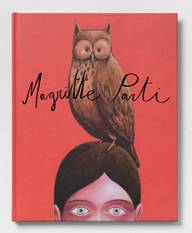
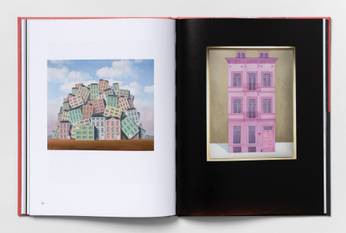
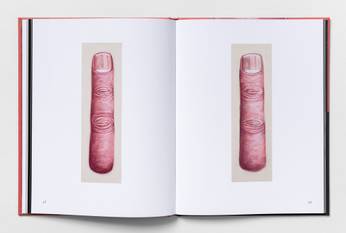
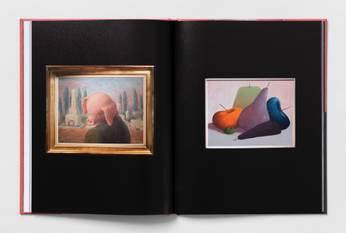
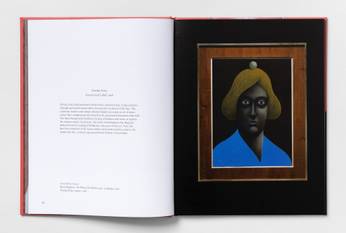
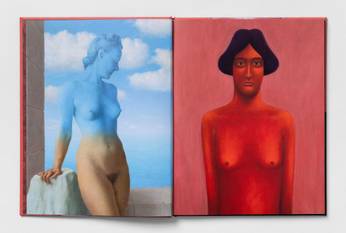

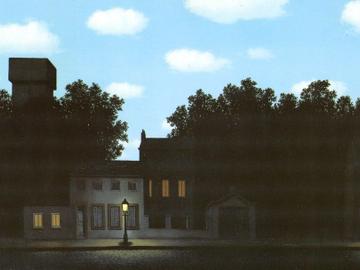


Fijn dat je wil reageren. Wie reageert, gaat akkoord met onze huisregels. Hoe reageren via Disqus? Een woordje uitleg.